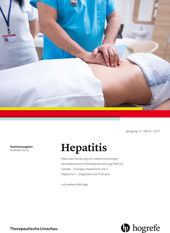Akute und chronische Hepatitis E
Abstract
Zusammenfassung. Das Hepatitis E Virus (HEV) ist eine der häufigsten Ursachen der akuten Hepatitis weltweit. Es wird bei uns als Zoonose hauptsächlich durch den Konsum von rohem oder unzureichend erhitztem Schweinefleisch oder Wild übertragen. Die autochthone Hepatitis E verläuft meist asymptomatisch oder mild, schwere Verläufe werden aber bei Patienten mit vorbestehenden chronischen Lebererkrankungen beobachtet. Neurologische Komplikationen, insbesondere die neuralgische Amyotrophie, sind Teil des klinischen Spektrums. Bei immunsupprimierten Patienten kann es zu einem chronischen Verlauf mit Übergang in eine Leberzirrhose kommen. In diesem Beitrag werden der aktuelle Stand und neue Entwicklungen in der Virologie, Epidemiologie, Diagnostik, Klinik, Therapie und Prävention der Hepatitis E zusammenfassend dargestellt.
Abstract. Hepatitis E virus infection is an important cause of acute hepatitis worldwide. It is a zoonotic infection in the Western world that can be transmitted through the consumption of raw or undercooked pork and game meat, with much higher than anticipated seroprevalence rates, a broad range of hepatic as well as extrahepatic, especially neurologic manifestations, and a potential to persist and to cause chronic hepatitis as well as cirrhosis in immunocompromised individuals. Here, we briefly review the current understanding and new developments in the virology, epidemiology, diagnosis, natural history, therapy and prevention of hepatitis E.



